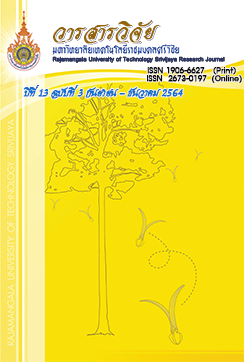Effect of Harvest Maturity on Potassium Value Secondary Metabolites and Antioxidant Activity of Orthosiphon aristatus (Blume) Miq.
Keywords:
antioxidant, Orthosiphon aristatus (Blume) Miq., total phenolic content, harvest maturityAbstract
This research investigated the effects of four stages of harvest maturity (30, 60, 90 and 120 days after planting) on potassium, secondary metabolites, and antioxidant activity of Orthosiphon aristatus (Blume) Miq. The experiment was arranged in a complete randomized design (CRD). Results showed that there were significant different harvesting maturities. The highest potassium content (5.02 g/100 g DW) was harvesting time at 30 days. The caffeic acid and rosmarinic acid (1.47 and 26.24 mg/kg DW) were highest with harvesting time at 60 days. In addition, the phenolic content and DPPH radical scavenging capacity (50.48 mgGAE/100 g DW and IC 50 being equal to 0.68 mg/mL) were found highest at harvesting time in 120 days after planting. Therefore, based on the findings, harvesting time at 120 days is recommended to farmers for optimum constituents of Orthosiphon aristatus (Blume) Miq. production.
References
Ali, M.B. 2014. Secondary metabolites and environmental stress in plants: biosynthesis regulation and function, pp. 55-85. In Ahmad, P. and Wani, M.R., eds. Physiological Mechanisms and Adaptation Strategies in Plants Under Changing Environment. Springer, Berlin.
Almatar, M., Ekal, E. and Rahmat, Z. 2014. A glance on medical applications of Orthosiphon stamineus and Some of its oxidative compounds. International Journal of Pharmaceutical Sciences Review and Research 24(2): 83-88.
AOAC. 2012. Official methods of the association of official analytical chemists. Association of Official Analytical Chemists, Washington D.C.
Babbar, N., Oberoi, H.S., Sandhu, S.K. and Bhargav, V.K. 2014. Influence of different solvents in extraction of phenolic compounds from vegetable residues and their evaluation as natural sources of antioxidants. Journal of Food Science and Technology 51(10): 2568-2575.
European Medicines Agency. 2010. Assessment report on Orthosiphon stamineus Benth., folium. Available Source: https://www.ema.europa.eu/en/documents/herbal-report/final-assessment-report-orthosiphon-stamineus
-benth-folium_ en.pdf, April 23, 2020.
Gai, F., Peiretti, P.G., Karamac, M. and Amarowicz, R. 2017. Changes in the total polyphenolic content and antioxidant capacities of perilla (perilla frutescens l.) plant extracts during the growth cycle. Journal of Food Quality 2017(2): 1-8. DOI:10.1155/2017/7214747.
Hossan, M.S., Rahman, S., Bashar, A., Jahan, R., Al-Nahain, A. and Rahmatullah, M. 2014. Rosmarinic acid: A review of its anticancer action. World Journal of Pharmacy and Pharmaceutical Sciences 3(9): 57-70.
Khatun, A., Harun-Or-Rashid, M. and Rahmatullah, M. 2011. Scientific validation of eight medicinal plants used in traditional medicinal systems of Malaysia: A review. American-Eurasian Journal of Sustainable Agriculture 5(1): 67-75.
Logeshbabu, M., Dhamotharan, R. and Janarthanam, B. 2017. In vitro antioxidant activity, total phenol and total flavonoid content of Orthosiphon aristatus (Blume). Miq. International Journal of Current Research and Development 5(1): 29-35.
Namjooyan, F., Azemi, M.E. and Rahmanian, V.R. 2010. Investigation of antioxidant activity and total phenolic content of various fractions of aerial parts of Pimpinella Barbata (DC.) BOISS. Jundishapur Journal of Natural Pharmaceutical Products 5(1): 1-5.
National drug information. 2016. Herbal medicine list. Available Source: http: //ndi.fda.moph.go.th/drug _national, April 23, 2020.
Oloyede, F.M., Oloyede, F.A. and Obuotor. E.M. 2013. Effect of plant maturity on the antioxidant profile of Amaranthus cruentus L. and Celosia Argentea L. Bulletin of Environment, Pharmacology and Life Sciences 2(2): 18-21.
Pettigrew, W.T. 2008. Potassium influences on yield and quality production for maize, wheat, soybean and cotton. Physiologia Plantarum 133(4): 670-681.
Phuranapong, N. and Nilawong, W. 2014. Plant nutrition release in the soils using different organic fertilizers. Available Source: http: http://webpac.library.mju.ac.th:8080/mm/fulltext/research/2558/Nongluk_Phuranapong_2557/fulltext.pdf, July 2, 2021. (in Thai)
Scheckel, K.A., Degner, S.C. and Romagnolo, D.F. 2008. Rosmarinic acid antagonizes activator protein-1-dependent activation of cyclooxygenase-2 expression in human cancer and nonmalignant cell lines. Journal of Nutrition 138(1): 2098-2105.
Singh, R.P., Murthy, K.N.C. and Jayaprakasha, G.K. 2002. Studies on the antioxidant activity of pomegranate (Punica granatum) peel and seed extracts using in vitro models. Journal of Agricultural and Food Chemistry 50(1): 81-86.
The Botanical Garden Organization Ministry of Natural Resource and Environment. 2013. Orthosiphon aristatus (Blume) Miq. Available Source: http://www.qsbg.org/database/botanic_book%20full%20option/search_detail.asp?botanic_id=2524, April 23, 2020.
Wang, H., Provan, G.J. and Helliwell, K. 2004. Determination of rosmarinic acid and caffeic acid in aromatic herbs by HPLC. Food Chemistry 87(2): 307-311.
Zorb, C., Senbayram, M. and Peiter, E. 2014. Potassium in agriculture - Status and perspectives. Journal of Plant Physiology 171(9): 656-669.
Downloads
Published
How to Cite
Issue
Section
License
The content and information in the article published in Journal of Rajamangala University of Technology Srivijaya It is the opinion and responsibility of the author of the article. The editorial journals do not need to agree. Or share any responsibility.







